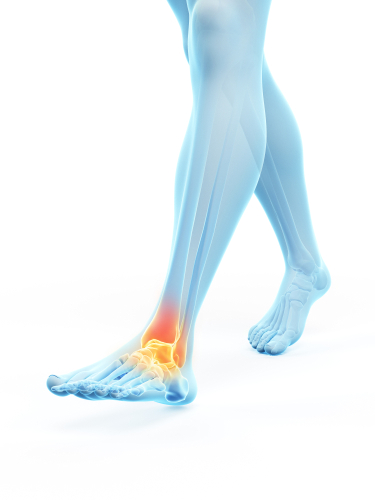
Multiple sclerosis (MS), a progressive neurological disorder, is characterized by the immune system mistakenly attacking the protective protein coating that surrounds nerve fibers, the so-called myelin sheath. Without this protection, nerve fibers are fragile and easily damaged, and eventually die.
The loss of nerve cells leads to the many symptoms of MS, including muscle weakness and spasms, fatigue, and problems with walking and balance. While symptoms may vary among individuals and across the different types of MS, one symptom that can be common to many patients is foot drop.
What is foot drop?
Foot drop occurs when a person lifts their foot while walking: instead of the toes lifting with the step, they drop, dragging on the ground. Foot drop makes it much more likely that patients will trip and fall while walking, especially on uneven surfaces like stairs.
Many people compensate by lifting their foot higher when walking, but this makes even short walks much more tiring. An odd gait can also lead to back and hip pain. And this gait can make patients more wobbly while walking, meaning they are more likely to stumble and fall.
Foot drop can also make other many aspects of daily life more challenging. Patients may have difficulty driving, for instance, because it can be hard to press on the vehicle’s foot pedals.
What causes foot drop?
Foot drop is caused by weakness in the ankle, largely due to a slowing or block in communication between nerves in the brain and the foot. Messages sent along nerve pathways that are interrupted or out of sync affect coordination between the leg and the ankle while walking. Normally, when taking a step, the muscles of the ankle tighten, keeping the toes tucked up during the step and relaxing when the heel touches the ground. Poor muscle coordination means that the toes are not kept at the proper angle when taking a step.
Other MS symptoms can also worsen foot drop. Loss of myelin affects nerve signaling, which can make it difficult to control movement of the legs and feet. Many patients have numbness or a frequent “pins-and-needles” tingling sensation in their hands and feet, making it harder for the brain to manage proprioception — the ability to sense where the limbs are at rest or in motion. Since the brain relies on sensations to coordinate limb movement, difficulties in managing proprioception make walking much more challenging.
How common is foot drop in MS?
Foot drop is thought to be common among people with MS, but its exact prevalence has not been established.
How can foot drop be identified?
People with trouble lifting their toes while walking may have foot drop. Anyone concerned with foot drop and difficulties with walking should schedule an appointment with their doctor or neurologist to confirm this condition and its degree, and to ask how it can best be treated.
Some patients may only have foot drop when they are tired. Keeping a log of symptoms experienced can help to keep track of when foot drop occurs or worsens. This kind of log or record also makes it easier for a physician to diagnose and treat the symptom.
How is foot drop treated?
For most people, foot drop can be managed through treatment and a few changes in lifestyle. Finding the optimal mix of options can take some time, however, and it is important for patients not to get discouraged.
Physiotherapy
A physiotherapist can assess the patient’s foot drop and develop an exercise program to help strengthen the leg, ankle, and foot muscles. They may also recommend exercises that can help with symptoms that may be making a person’s foot drop worse, like fatigue and muscle spasms or cramps. Some patients may have developed problems with gait or stride that make foot drop more likely. A physiotherapist can advise on exercises to address these problems.
Some patients may need regular therapy sessions to exercise under professional supervision, while others may be able to perform their exercises at home with only occasional physiotherapy sessions.
Occupational therapy
Occupational therapy is slightly different from physiotherapy, in that occupational therapists help patients find more efficient ways to perform daily tasks or chores — at home, school, or work — so they are easier and safer to do, and less tiring.
MS patients can meet with an occupational therapist to discuss ways of managing foot drop. This consultation may take place in coordination with a physical therapist.
An occupational therapist can also prescribe adaptive devices like canes, orthotic braces, and wheelchairs or motorized chairs to make movement less demanding.
Aids and adaptive devices
A variety of aids and adaptive devices can help patients with walking, such as canes and braces.
An ankle orthotic brace is a device made of plastic or carbon fiber that is strapped to the ankle and foot, and holds the foot and ankle in a proper walking position to prevent the foot from dropping. Orthotic braces are usually worn under socks and other clothes.
Orthotic braces can be helpful for some patients. But for others, these braces can make walking more tiring.
Functional electrical stimulation (FES)
Functional electrical stimulation (FES) is a therapy that uses a device to apply small pulses of electricity to the nerve cells connecting to muscles. For foot drop, FES can be used to stimulate the nerves in the foot and leg while a person is walking. This small device is worn on the waist or leg and controlled by a sensor in the patient’s shoe. A physiotherapist trained in FES can determine whether the approach may be useful for a particular patient.
FES relies on the existing nerve fibers between the brain and the feet, so if these nerves are badly damaged, it may not be effective.
Surgery
In exceptional cases, surgery may be considered for foot drop due to MS. Surgery is used to fuse the bones of the ankle or the foot to make walking more stable, or to connect the tendons of a working muscle to another area of the foot to help the ankle pull the toes up with each step. These types of surgery can make walking more stable for some people, and may be done to treat foot drop due to a stroke or injury. But as MS is a progressive disease that damages nerves in the brain and spinal cord, it is not likely to be advised for patients.
Tips for avoiding falls
In combination with treatments and physical therapy, patients may be able to lessen a risk of falls due to foot drop by making small lifestyle changes.
Here are some tips to avoid falling:
Wear good shoes
Patients should choose footwear that fits well and offers good support. Shoes with fasteners, ties, or laces are better than slip-on shoes, which may become loose and slip from foot. Boots can provide good ankle support, but it is important to avoid heavy footwear that drag on the feet with each step. Patients should also choose shoes with good non-slip treads that are suitable for multiple surfaces.
Shoes with high heels should be avoided; in addition to being less stable, prolonged use of high heels can cause shortening of the tendons at the heel (the Achille’s tendon), which can make walking more difficult in the long term.
Be alert when walking
If a person knows that they are prone to foot drop or finds walking difficult, they should plan their routes to avoid obstacles that could be challenging or dangerous. If walking distances are problematic, in addition to using aids it may be necessary to get a handicap placard or license plate for the car. The doctor’s office can help with the process of getting handicap placards or plates.
Monitor fatigue
Foot drop is more likely to occur when a person is tired. MS is often marked by chronic fatigue, but patients can have times of higher energy. Organizing the day in a way that “running errands” and the like are done while fresh can help. Those who must walk when tired should put aside sufficient time so as not to rush about, and stay focused on picking up their feet when walking. Wearing braces and taking a cane on days when feeling fatigued is also a good idea.
Keep home areas clear
Keeping the home clear of obstacles or tripping hazards is important. This can be challenging in the day-to-day, especially when dealing with MS fatigue, but a home’s main walking routes should be kept clear of clutter. If electric cables or wires are stretched across walkways, these should be removed by connecting plugs to different outlets, or taping cables down so that they’re a less likely tripping hazard. Mats or rugs on the floor that can catch feet should be removed, taped down, or replaced with non-slip rugs.
If the home has stairs, there may be ways of making movement up and down these stairs easier. For example, a ramp can be installed for entrances and a chair-lift for inside stairs. If accommodations like these are not possible, it may be necessary to rearrange living spaces, like moving the bedroom to the ground level, so that the patient does not have to climb stairs when tired and wanting to rest or sleep.
Last updated: Oct. 23, 2019
***
Multiple Sclerosis News Today is strictly a news and information website about the disease. It does not provide medical advice, diagnosis, or treatment. This content is not intended to be a substitute for professional medical advice, diagnosis, or treatment. Always seek the advice of your physician or other qualified health provider with any questions you may have regarding a medical condition. Never disregard professional medical advice or delay in seeking it because of something you have read on this website.




